Wholesale Price Index (WPI) and Consumer Price Index (CPI) are two crucial metrics that help in defining the prices of the goods and services in an economy. Or, we can say both WPI and CPI are taken into account for measuring inflation. Thus, both the terms are often used to convey the same things, but they are very different. Also, when there is a talk about inflation, many don’t know if it is related to the WPI or CPI. Therefore, it is very important to understand the difference between WPI vs CPI.
Before we detail the differences between WPI vs CPI, let us understand what both these terms mean.
WPI vs CPI – Meaning
WPI suggests the price changes in the wholesale market or the changes in the price that manufacturers and wholesalers charge. It is the first level reflecting the increase or decrease in the prices. WPI covers goods only, such as fuel and power, primary articles, and more.
Consumer Price Index or CPI is an index that measures the average retail price of consumer goods and services. These goods and services range from food items to medical care and transportation. Generally, there are eight categories included in the consumer price index. These categories are – Foods, Beverages, Medical Care and Recreation, Communications, Education, Garment, Transportation, and Housing. CPI is also sometimes referred to as the standard retail price. It helps to actively to pinpoint the inflation and deflation cycle in the economy.
Of the two, WPI is less popular as only a few countries use it. On the other hand, roughly 157 countries use the consumer price index.
Also Read: Inflation and Deflation
WPI vs CPI – Differences
Following are the differences between WPI vs CPI:
What Each measure?
WPI measures any change (up or down) in the price of goods charged by the whole seller. On the other hand, CPI measures the change in the retail prices of goods and services or the price that the end-user eventually pays.
Release Date
WPI is usually released on a weekly basis, while CPI releases on a monthly basis.

Goods or Services
In the case of the wholesale price index, only goods are taken into account. We have already talked about the items that come under the wholesale price index. The consumer price index, on the other hand, includes both goods and services.
Items included
In the wholesale price index, primary articles, fuel & power and manufactured goods are included. Primary items are both food and non-food items and minerals. Fuel and power include electricity, coal mining, mineral oil and more. Manufactured goods include beverages, tobacco products, wood products, paper products, textiles, basic material, rubber and rubber products, etc. The list of manufactured products can be as long as 500 items or even more.
The consumer price index includes about eight categories of products and services such as Education, Recreation, Apparel, Transportation, Food and beverages, housing and medical care. The total number of products in CPI could range from 450 to 460.
Base Year
For the consumer price index, the base or reference year is the calendar year. For WPI, on the other hand, the base or reference year is the financial year.
Stage of Measurement
The wholesale price index measures inflation in the first stage, reflecting the change in the prices of goods charged by the manufacturer or seller. The consumer price index is more about retail and, therefore, calculates the final stage of inflation.
Importance
WPI is of importance to those who keep track of the wholesale prices. On the other hand, CPI is of importance to the general public as it keeps them informed about their financial well-being.
Final Words
Overall, the consumer price index (CPI) focuses more on inflation and its impact on the entire economy. And this is the reason it is used more often than the wholesale price index. Government, however, keeps a watch on both the metrics to keep inflation under check.
RELATED POSTS
- Theory of Demand – Meaning, Demand Curve, Exception, and Graph
- Laspeyres Index – Meaning, Calculation, Example, Advantages, and Disadvantages
- What are the Types of Elasticity?
- Inflation
- Price Floor and Ceiling – Meaning, Example, and More
- Laspeyres Vs Paasche Index – Explanation, Importance and Difference

